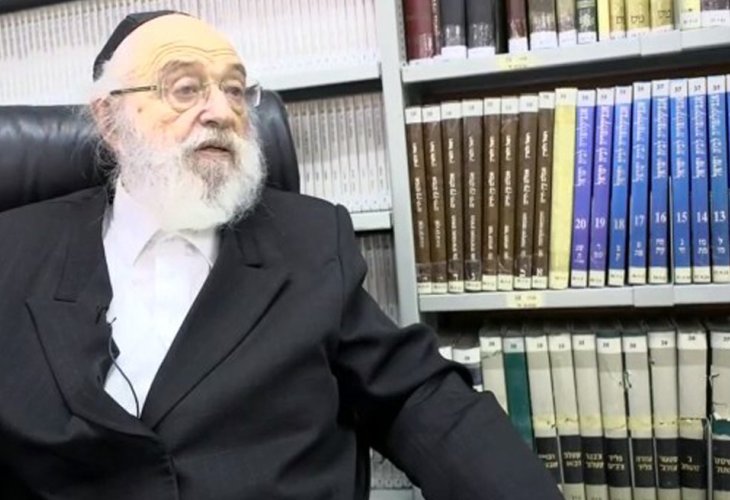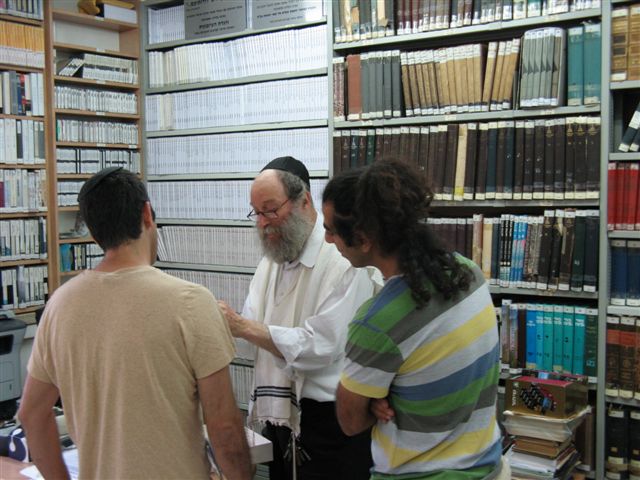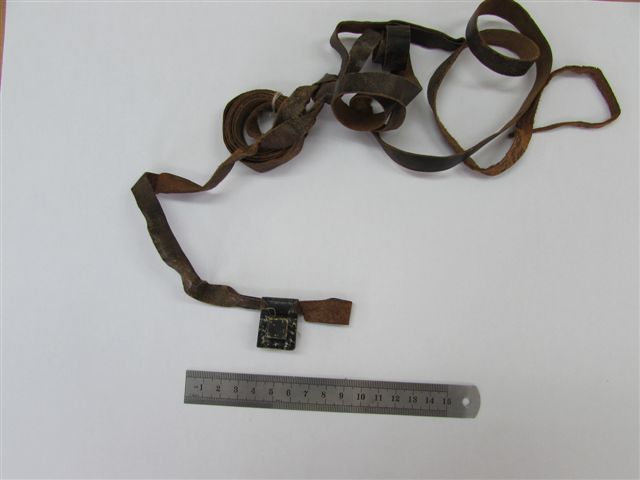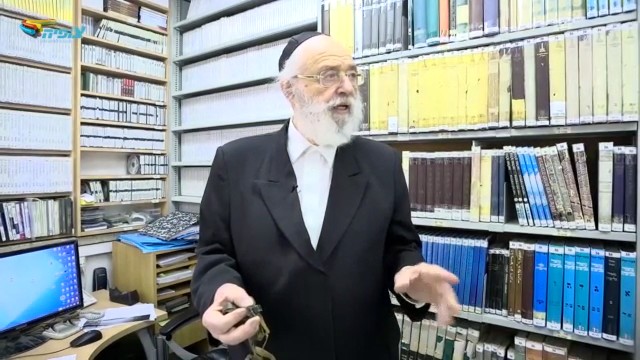"You Hear Heartfelt Testimonies, with No Explanation Except for Amazing Spiritual Heroism"
Rabbi David Skolsky has managed the Kadosh Hashem Archive for over half a century, documenting Holocaust events. "We have collected thousands of testimonies, and the more we speak with Holocaust survivors, the more we understand - their spiritual heroism was incomprehensible."
- מיכל אריאלי
- פורסם כ"ח ניסן התשע"ז
 Rabbi David Kolesky
Rabbi David Kolesky #VALUE!
![]()
![]()
![]()
![]()
When discussing the destruction of European Jewry, one cannot overlook the Kadosh Hashem Archive located in Bnei Brak, where numerous testimonies from the war years have been preserved over the past decades.
"We have nearly 300,000 documents and photos, films and recordings, research and personal interviews with Holocaust survivors," Rabbi David Skolsky, CEO of Kadosh Hashem Archive, tells us. "In addition, the institute has a rich library with thousands of books on Jewish and spiritual heroism during the Holocaust, and the archive itself serves as a publishing house for many books documenting those days."
Watch the feature made as part of the news edition of Tsofia, the kosher converter (for details - 073-3333-333):
On the moment that led him to engage in the field, he shares: "In my youth, I studied at Kolel Gur, where Rabbi Moshe Frager, a Holocaust survivor who wrote many books on the Holocaust, served on the board. One day, I met him, and he asked, 'What do you think of our kolel?' I replied that the combination between those who did not give in and those who do not give in is fascinating to me. He asked me to elaborate, and indeed I arrived at his home and we talked at length. I explained to him that my feeling is that the young men who studied before the Holocaust in the shtiebels and synagogues in Europe could not have imagined they would be able to withstand such harsh trials and survive, but ultimately, one can see they stood bravely through unimaginable trials. I told Rabbi Frager that I wish for our young men not to have to prove themselves and stand such trials, but I hope with all my heart that we will succeed in continuing the tradition and inherit the miraculous strength the Jews possessed during the Holocaust. Rabbi Frager apparently enjoyed my words, and since then my soul became bound to his, and for more than fifty years I have been here at the Kadosh Hashem Archive."
"Personally, I also feel a direct connection to this enormous project," he adds. "Although my parents immigrated from Europe in 1937 before the outbreak of the war, my aunt, my father's sister, survived Auschwitz and she told us terrifying stories about everything that happened there. Thus, we grew into it."

Our Goal: To Prove Spiritual Heroism
Rabbi Skolsky says that the archive's purpose can be summed up in a few words: documenting the expressions of Jewish and spiritual heroism and acts of sanctifying Hashem's name during the war and the Jewish life of that time worldwide.
"Indeed, there are other museums in the country dedicated to the commemoration of the Holocaust, but we emphasize the spiritual aspect here. It is important for us to raise awareness of the Jewish soul's heroism during the Holocaust and instill this in the youth both in Israel and the entire Jewish world. For this purpose, we organize exhibitions, study days, and various documentations. We also have different exhibits and manuscripts that we display at the institute, as well as religious artifacts preserved from the Holocaust," he shares.
And Rabbi Skolsky presents us with tefillin of one centimeter by one centimeter, written in beautiful and precise handwriting. "The Jewish man who wrote them did so in the ghetto during the Holocaust, seeing what was happening around him, understanding that it was uncertain what would happen to him tomorrow. He was not obligated to don tefillin, but he did not give up; he insisted on having a pair of tefillin. The person who brought us this tefillin was the grandson of a Jew who found them on the head of one of the dead. He couldn’t reach the hand tefillin because the hand was buried under a pile of corpses... but he found and took the head tefillin. Later, he passed them on to his son, and his son gave them to us. And this is just one example of our exhibits, as we have become a destination for anyone interested in books, albums, material, and photographs on the Holocaust and Jewish life of those days. Authors, researchers, journalists, teachers, artists, lecturers, publishers, and interested parties from around the world come here, but more than anything, we see our mission as reaching the youth."


Why Especially for Teenagers?
"It is most important for us to convey to future generations the strong and mighty message that the Jews, in all situations, even the toughest ones, managed to survive and cope with the strength of mind and spirit. This message is particularly important for the youth, so they know how their grandparents gave their lives on the smallest details of the faith and, in the toughest situations, held on to their Judaism. For this purpose, we run workshops, booklets, and study days specifically aimed at the youth. This is our message, this is our goal."
To Remain Jewish Moments Before Death
One of the touching testimonies documented in the Kadosh Hashem Archive is that of Rabbi Mordechai Guterman. "He is no longer with us today," Rabbi Kolesky shares, "but when we talked with him in the past, he recounted how they performed backbreaking work, including being required to level a track between two mountains. They had two options - either drag the stones to the valley or dig into the mountains to level the track. He was a young boy at the time and thought: 'Digging on Shabbat is a biblically prohibited action, while dragging stones to the valley is rabbinically prohibited.' Ultimately, he preferred to do backbreaking work and drag the stones to the valley, which was several times more difficult than digging into the mountains, just to avoid a biblically prohibited action. Whenever I recount this story, I am moved because the young men of that time had unbelievable mental strength."
"Another Holocaust survivor I spoke with was a young boy during the war. He told us that when he was in Auschwitz, the Nazis appointed him in charge of bread distribution. That meant he was responsible for opening and closing the storage, and at the end of the day, the bread slices were counted, and woe to him if a slice was found missing in the inventory. One day, as he lay on the bunk, someone knocked on the door and signaled him to come over. 'I have a request,' the Jew at the door whispered to him, 'tomorrow evening is the start of Sukkot. I've heard you're in charge of the bread, and I want you to take out two loaves so I can make the blessing on them. I've already set up a sukkah, and now I need two loaves. I promise I'll break off only a tiny crumb for the blessing and then return both loaves whole. I just want to be able to fulfill the mitzvah in the sukkah.'

"The young man told us he replied, 'Alright, I'll give you two loaves, but on one condition - I go with you.' Initially, the Jew resisted: Why should you put yourself at risk? But the young man insisted: 'If you don't include me, you won't get the bread.' Eventually, they both went to the sukkah that the Jew had managed to assemble from various planks. They stood under the sukkah, blessed over the bread, prayed, and concluded by saying to one another, 'Thanks to the mitzvah of sukkah, we will be delivered.' Years later, the young man, now grown, traveled to visit his brother in Venezuela. One day, while he was there, someone approached him at the synagogue and said, 'Tomorrow, a well-informed Jew named David Yisrael will arrive here. It's worthwhile to meet him.'
"And indeed, we met," he recounted. "David Yisrael arrived with a long beard and shared how he survived Auschwitz and managed to blow the shofar and that there was a boy who helped him by giving him bread, allowing him to also fulfill the mitzvah of sitting in the sukkah. I felt as if I was going to faint and told him with great emotion, 'That boy was me.' Indeed, thanks to the mitzvah of the sukkah, both of us were saved."
Tsofia's project is enjoying great success. Many households have already understood that it is possible to watch completely kosher and safe content, thereby improving their quality of life.
Tsofia now includes two continuous content channels for children and toddlers, a Jewish music channel, and is establishing a film channel for Haredi creators, in addition to the world's largest Torah media library and the Hidabrut and Tsofia channels broadcast around the clock. But that's not enough: these days, Tsofia is preparing for a daily broadcast of a news edition. The edition will cover events in Israel and the world without gossip, tailored to the Torah-observant and mitzvah-keeping audience.
For details: 073-3333-333 or visit the website Tsofia, the kosher converter.

